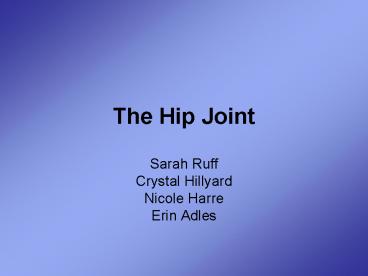The Hip Joint - PowerPoint PPT Presentation
1 / 25
Title:
The Hip Joint
Description:
The acetabulum is formed by the pubis, ischium and ilium bones. Joint Capsule ... Then evulse the head of the femur to view the internal structure of the joint ... – PowerPoint PPT presentation
Number of Views:155
Avg rating:3.0/5.0
Title: The Hip Joint
1
The Hip Joint
- Sarah Ruff
- Crystal Hillyard
- Nicole Harre
- Erin Adles
2
The Hip Joint
- The hip joint is formed by the articulation of
the head of the femur into the acetabulum of the
hip. - ball-and-socket joint.
- Synovial joint
3
Bones
- Ilium
- Ischium
- Pubis
- Femur
- The acetabulum is formed by the pubis, ischium
and ilium bones
4
Joint Capsule
- Strong fibrous sleeve
- specialized thickening, called ligaments, add
stability - Anteriorly
- proximally to the bone surrounding the
acetabulum. - Distally to the trochanteric line
- Posteriorly
- to the margins of the acetabulum and surrounding
bone - neck of the femur- not to the trochanteric crest
5
Ligaments
- Iliofemoral ligament- strongest ligament in the
human body. It attaches to the illium between the
two heads of the rectus femoris muscle. It is Y
shaped. One goes to the base of the greater
trochanter and the other to the base of the
lesser trochanter. Seeks to resist excessive
extension of the hip joint. - Ischiofemoral ligament- attaches from the ischial
part of the acetabular rim to the femur.
Posterior joint capsule is reinforced by this
ligament. - Pubofemoral ligament- attaches to the base of the
lesser trochanter and the superior ramus of the
pubis, just above the obturator foramen. It is
inferior to the iliofemoral ligament and
reinforces the inferior part of the hip joint
capsule. It also blends with the medial parts of
the iliofemoral ligament
6
Ligaments (cont.)
- The round ligament of the head of the femur is
attached to the transverse acetabular ligament
and extends to the fovea centralis on the head of
the femur - A fibrocartilaginous ring called the acetabular
labrum deepens the acetabulum and clasps the head
of the femur which makes the joint more stable
7
(No Transcript)
8
(No Transcript)
9
(No Transcript)
10
Muscles
- External rotators piriformis, quadratus femoris,
Obturator internus and externus, gemellus
superior and inferior, - Flexors iliopsoas, rectus femoris
- Adductors adductor magnus, adductor longus and
brevis, pectineus, gracilis - Internal rotators gluteus medius, gluteus
minimus, tensor fascia latae - Extensors semitendinosus and semimembranosus,
biceps femoris, gluteus maximus - Abductors gluteus medius, gluteus minimus
11
Nerves
- Femoral
- Obturator
- Sciatic
- Nerve to quadratus femoris
- Direct branches of sacral plexus
12
Blood Supply
- Medial Circumflex
- Lateral Circumflex
- Obturator
- Inferior gluteal
13
Movements
The hip joint is the most mobile joint in the
lower limb. It is capable of flexion and
extension, abduction and adduction, medial and
lateral rotation and all of these in a circular
motion- circumduction second largest
range of movement (second only to the shoulder)
supports the weight of the body, arms and head.
14
Movements
- Flexion- mainly due to contraction of the
iliopsoas muscle, with help from the sartorius,
rectus femoris, and pectineus - Extension- chiefly by the guteus maximus muscles
with help by the hamstrings - Adduction- by the adductor longus, brevis, magnus
and the gracilis - Abduction- by the gluteus medius and gluteus
minimus - Lateral rotation- by the gluteus maximus,
quadratus femoris, piriformis, obturator internus
and externus, gemelli - Medial rotation- by the anterior part of the
glueteus minimus and medius and tensor fasciae
latae muscles
15
What causes Hip pain?(refer to your Hip handout)
- Arthritis
- Throchanteric Bursitis
- Tendonitis
- Osteonecrosis
- Lumbar pain- referred symptoms
- Snapping hip syndrome
- Muscles strains
- Hip fracture
- Childhood hip problems
- Developmental dysplasia
- Legg-calve-perthes disease
16
Treatments
- Rest
- Ice and heat application
- Stretching
- Physical Therapy
- Anti-inflammatory Meds
- Hip Replacement
17
Treatments (cont.)
- Hip Replacement
- First performed in 1960
- More than 193,000 total hip replacements each
year - Benifical if
- Hip pain limits ADLs like walking or bending
- Hip pain continues while resting, either day or
night - Stiffness in hop limits mobility
- Little relief from medications
- No relief after physical therapy or use of gait
aid such as a cane
18
Treatments (cont.)
- Hip Replacement
- Surgery
- Admission into hospital
- General anesthesia or spinal anesthesia
- Usually takes a few hours
- Process- removal of damaged cartilage and bone,
they then position new metal, plastic, or ceramic
joint surfaces to restore alignment and function.
A ball and socket component is used. Surgical
cement may be used to fill the gap between
prosthesis and remaining bone to secure the new
joint - In younger- more active patients, non-cemented
prosthesis so the bone can grow into the
prosthesis.
19
Dissection
With Cadaver in Supine position, find the Rectus
Femoris muscle (1) and the Sartorius muscle (2)
20
Reflect the Rectus Femoris and Sartorius muscles
to expose the Pectineus and Iliopsoas muscles.
21
Reflect the Iliopsoas and Pectineus muscles to
expose the hip joint capsule.
22
Identify the following pubofemoral ligament (2)
which is partially seen inferiorly and the
ischiofemoral ligament (1) which is viewed
posteriorly.
23
Open the Capsule along in the same direction of
the capsular ligaments to expose the head of the
femur. The arrow points to where the hip capsule
has been opened.
24
Then evulse the head of the femur to view the
internal structure of the joint including the
round ligament of the femur.
http//www.meddean.luc.edu/lumen/meded/grossanatom
y/dissector/labs/le/joint/main.html
25
Final Note
- Refer to the handout that was given to us last
Monday in class regarding hip injuries and
diseases. We found this very helpful as well!

